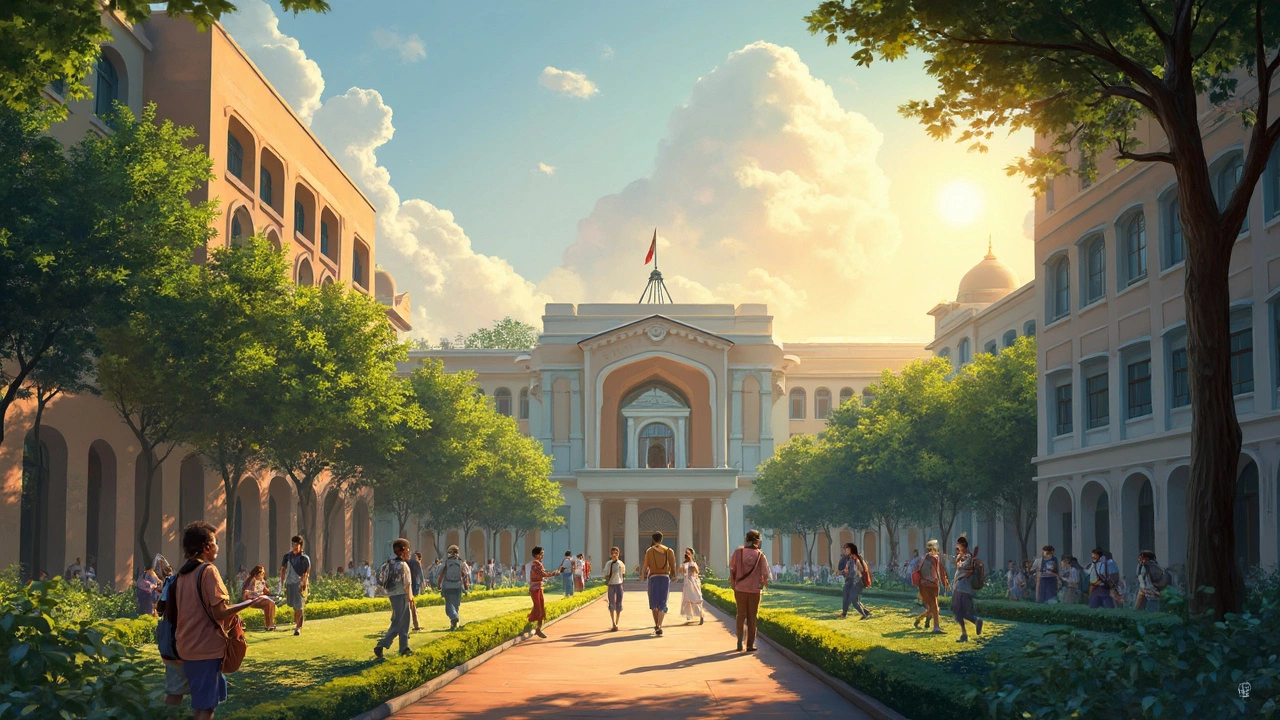Most engineering aspirants throw the word 'IIT' around like it's one monolithic thing. Here's something a lot of students don't realize—there are actually 23 IITs spread across India, not just a handful in the big cities. This number matters. Each campus has its own atmosphere, strengths, and quirks.
And the number isn't random. The very first IIT popped up in Kharagpur in 1951—basically as an experiment that worked better than anyone expected. Now, with 23 IITs, you’ve got more choices than ever. That changes your odds, and maybe even your path if you’re aiming for the JEE. People often focus just on the old, famous names. But the newer IITs? They’ve got state-of-the-art labs, energetic young faculty, and sometimes, if you look closely, better odds for the stream you want.
If you’re filling out your choices this year, you shouldn’t just tick off the top 5 and hope for the best. Each IIT has its own entrance cut-offs and programs—so knowing the latest list isn’t just trivia. It’s practical. It helps you plan your backup strategy and gives you more options to land an awesome branch in a solid campus. Nobody wants last-minute panic when the seat allocation opens, right?
- Updated Count: How Many IITs?
- A Quick Look at Each IIT
- Why the Number of IITs Matters
- Choosing Your IIT: Smart Tips
Updated Count: How Many IITs?
Most students still get surprised when they hear the actual number of IITs in India. As of May 2025, there are 23 IITs in India. This isn’t just a growing list; each new campus brings in its own way of teaching, new tech labs, and a fresh pool of opportunities for JEE aspirants.
The IIT system started off back in 1951 with just one campus—Kharagpur. Over the years, more IITs have been set up to make top-class engineering accessible in different regions. The latest addition is IIT Bhilai, which started in 2016. These include the famous "old IITs" (like Bombay, Delhi, Madras) and the so-called "new IITs." Here’s a quick snapshot to clear up any confusion about the names and locations:
| S. No. | IIT Name | Location | Year Established |
|---|---|---|---|
| 1 | IIT Kharagpur | West Bengal | 1951 |
| 2 | IIT Bombay | Maharashtra | 1958 |
| 3 | IIT Madras | Tamil Nadu | 1959 |
| 4 | IIT Kanpur | Uttar Pradesh | 1959 |
| 5 | IIT Delhi | Delhi | 1961 |
| 6 | IIT Guwahati | Assam | 1994 |
| 7 | IIT Roorkee | Uttarakhand | 2001 |
| 8 | IIT Bhubaneswar | Odisha | 2008 |
| 9 | IIT Gandhinagar | Gujarat | 2008 |
| 10 | IIT Hyderabad | Telangana | 2008 |
| 11 | IIT Jodhpur | Rajasthan | 2008 |
| 12 | IIT Patna | Bihar | 2008 |
| 13 | IIT Ropar | Punjab | 2008 |
| 14 | IIT Indore | Madhya Pradesh | 2009 |
| 15 | IIT Mandi | Himachal Pradesh | 2009 |
| 16 | IIT Varanasi (IIT BHU) | Uttar Pradesh | 2012 |
| 17 | IIT Palakkad | Kerala | 2015 |
| 18 | IIT Tirupati | Andhra Pradesh | 2015 |
| 19 | IIT Bhilai | Chhattisgarh | 2016 |
| 20 | IIT Goa | Goa | 2016 |
| 21 | IIT Jammu | Jammu & Kashmir | 2016 |
| 22 | IIT Dharwad | Karnataka | 2016 |
| 23 | IIT Dhanbad (ISM) | Jharkhand | 2016 |
Funny thing—ask any old-timer, and they’ll probably recall just the first five or six IITs. These days, when you’re looking at your JEE options, you’ve got campuses from all corners of the country. That’s why it’s smart to know the full list, not just the most talked-about ones.
- The original five (Kharagpur, Bombay, Madras, Kanpur, Delhi) have been around for decades and are usually more established.
- The "new IITs" sometimes get written off, but some have already built a stellar reputation for certain branches or placement rates.
- Seat counts, closing ranks, even hostel life can vary wildly between campuses—so, a wider IIT network means more options for smart applicants.
This updated count isn’t just a number—it widens your playing field and puts more choices in your hands the next time you’re eyeing that seat matrix.
A Quick Look at Each IIT
So, what's the deal with all these different IITs? There are 23 IITs, but each has its own flavor. Let’s break them down so you actually know what’s out there instead of just hearing the old "IIT is IIT" line. Here’s a solid list of all the IITs in India as of May 2025, along with the year they started and where you’ll find them:
| Name | Location | Year Established |
|---|---|---|
| IIT Kharagpur | West Bengal | 1951 |
| IIT Bombay | Mumbai, Maharashtra | 1958 |
| IIT Madras | Chennai, Tamil Nadu | 1959 |
| IIT Kanpur | Uttar Pradesh | 1959 |
| IIT Delhi | Delhi | 1961 |
| IIT Guwahati | Assam | 1994 |
| IIT Roorkee | Uttarakhand | 1847/2001* |
| IIT Bhubaneswar | Odisha | 2008 |
| IIT Gandhinagar | Gujarat | 2008 |
| IIT Hyderabad | Telangana | 2008 |
| IIT Jodhpur | Rajasthan | 2008 |
| IIT Patna | Bihar | 2008 |
| IIT Ropar | Punjab | 2008 |
| IIT Indore | Madhya Pradesh | 2009 |
| IIT Mandi | Himachal Pradesh | 2009 |
| IIT Varanasi (BHU) | Uttar Pradesh | 1919/2012* |
| IIT Palakkad | Kerala | 2015 |
| IIT Tirupati | Andhra Pradesh | 2015 |
| IIT Bhilai | Chhattisgarh | 2016 |
| IIT Goa | Goa | 2016 |
| IIT Jammu | Jammu & Kashmir | 2016 |
| IIT Dharwad | Karnataka | 2016 |
| IIT (ISM) Dhanbad | Jharkhand | 1926/2016* |
*Some IITs like Roorkee, Varanasi, and Dhanbad were existing technical schools that joined the IIT group later, so you’ll see two dates for them.
The older IITs—like Kharagpur, Bombay, Madras, Kanpur, and Delhi—are what people call the "top five". They’ve got the deepest alumni networks, some crazy research labs, and a track record for placing folks in big companies. But seriously, the new-gen IITs (opened 2008 onwards) aren’t just backups. If you want a chill, smaller campus or you’re excited about being in a young, growing place, these can be solid bets. Some of my friends picked IIT Gandhinagar because of its great hostels and flexible study options, or chose Hyderabad for the startup vibe and modern setup.
- IIT Hyderabad is big on innovation and robotics—with industry tie-ups that lead to hands-on internships.
- IIT Mandi is tucked into the mountains, which means unbeatable scenery and a tight-knit community feel.
- IIT Roorkee is famous for civil engineering—and the campus has real old-school charm.
- IIT Kanpur is the place for aerospace or core engineering buffs.
- IIT Bombay and Delhi land the hottest placements in tech and consulting—those Google and Microsoft interviews? They usually hit these first.
Each IIT even has signature events—like IIT Bombay’s Mood Indigo, which honestly feels like a college version of a music festival. When you’re choosing where to aim, don’t ignore these little details; the campus culture makes a difference, and you want to enjoy your four years too, not just slog it out for grades.

Why the Number of IITs Matters
The fact that India now has 23 IITs changes the game for everyone chasing an engineering dream. You’re probably thinking, "More IITs, more seats, so easier to get in?" Well, it’s not quite that simple, but it does shake things up for every serious aspirant.
Check out this quick data to see the jump over the years:
| Year | Total IITs | Total Seats (approx.) |
|---|---|---|
| 2000 | 7 | ~3,800 |
| 2010 | 15 | ~7,500 |
| 2024 | 23 | ~18,300 |
This jump isn’t just about numbers. Here’s why it matters to you when thinking about IITs in India:
- More Seats, More Chances: You’ve got nearly five times as many seats as students did two decades ago. That means cut-off ranks shift, especially for general and reserved categories.
- Wider Choice of Programs: Earlier, some branches like Computer Science or Electrical Engineering were available only in the main IITs. Now, newer IITs offer them too, and sometimes with less competition.
- Location Options: You don’t have to move across the whole country for a top-class engineering education. There’s likely an IIT in your time zone or region, which helps with travel and family stuff.
- More Campus Cultures: Not all IITs feel the same. Newer ones come with fresh clubs, start-up scenes, and sometimes more experimental teaching styles.
The flip side? A bigger list means you need to research more carefully. Some companies still visit the older IITs first for placements, but many top recruiters are now showing up at the new campuses too. Some smaller IITs have newer infrastructure, which can mean cutting-edge labs or, honestly, buildings still getting finished. So, it’s up to you to match your goals with what each IIT offers. The expansion is a win—as long as you use it smartly.
Choosing Your IIT: Smart Tips
Picking the right IIT is more than just snagging a seat. Every IIT has its own vibe, resources, and opportunities. So, how do you narrow it down without getting overwhelmed by the sheer number?
- Location Actually Matters: If family visits or weather are big for you, think about campuses closer to home, or where the temperatures don’t hit extremes. For example, Kharagpur can get pretty hot, and Guwahati’s scenic but has its own monsoon challenges.
- Check the Department Strengths: Just because one campus is older doesn’t mean every branch is top tier there. For instance, IIT Madras is famous for Mechanical and Computer Science, while IIT Roorkee shines in Civil.
- Placement Stats Aren't Hype: Don’t just go on brand. Look at the placement percentage and average salary for your branch. Here’s a quick view from 2024 for B.Tech CSE:
| IIT Campus | Highest CSE Package (INR) | Average CSE Package (INR) | Placement % |
|---|---|---|---|
| IIT Bombay | 3.7 Cr | 38 L | 95% |
| IIT Delhi | 4 Cr | 38.5 L | 98% |
| IIT Kanpur | 4 Cr | 33 L | 93% |
| IIT Hyderabad | 1.82 Cr | 35 L | 96% |
- Campus Life is Real: Don’t skip checking out hostels and clubs. Some newer IITs have swankier buildings and less crowd.
- Faculty and Research: If you’re eyeing higher studies, check lab facilities and specialization areas. New IITs like IIT Gandhinagar and IIT Ropar are pumping up their research big-time, not just following the old IITs’ shadows.
One last thing—don’t only focus on the big names. Newer IITs sometimes offer more flexible branch change policies because intake is smaller, which is handy if you want to swap streams after first year.
At the end of the day, look beyond the IITs in India hype and pick what fits you: location, faculty, culture, placements—whatever tips the balance for your future. Make your decision based on facts, not just brand value or FOMO.




